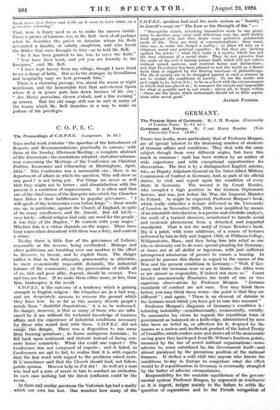SOME TOURISTS AND A PILGRIM.
Through Central France to the Pyrenees. By Maude Speed. With sketches by the Author. (Longman. 10s. 6d.) Hilltowns of the Pyrenees. By Amy Oakley. Illustrated by Thornton Oakley. (Long. 21s.) Men, Maidens and Mantillas. By Stella Burke May. Illus- trated with photographs. (Long. 15s.) A Pilgrim in Spain. By Aubrey F. G. Bell. Illustrated with photographs. (Methuen. 12s. 6d.)
MRS. SPEED runs airily through Central France, seeing all the
obvious places and not thinking it amiss to write up the obvious historical explanations for other tourists. What impressed her most, however, was that French servants did their job as if they had their heart in it. Where she got good entertainment cheap she notes the fact ; when she had to pay for exceptional cookery she observes that an artist's work must he paid for. Wise lady : wise also because she went in spring. Her wash drawing of Carcassonne is slight, but it gives the effect of an old fortified town in the South.
Mr. Oakley's etchings of the same place, and of all the places that Mrs. Oakley writes about, seem to have come out of a sunless inferno. Mrs. Oakley is an ejaculatory tourist, and often describes the feelings which inevitably rose up in historic places. Does anyone ever really feel those feelings ? The great point - about Mrs. May, who was an American tourist in Latin America, is her simplicity. She does not get below the surface anywhere, but she is amusing about the life on top. Her special interest was to find manifesta- tions of feminist progress in Mexico, Peru and so forth, but she frankly leaves the impression that things go on much as before—with one exception. Juliet still receives from her balcony the addresses of Romeo in the street, and still drops to him the cord—not of a ladder, but of a pocket telephone. The duenna within can see that the accredited man is at the other end ; conversation is less embarrassed, though the proprieties are strictly observed. Excellent idea.
Mr. Keith Henderson's brilliant drawings have more value than the airy impertinence of his prose: yet there are moment% when that also has distinction : for instance, when he jots down his first vision of a flying fish. As for birds, he has the cult of them, and proves it by his writing as well as by his
pictures. Mr. Aubrey Bell is in another category altogether. A finished writer, he gives us intimate studies of Spain where lie
has lived and really travelled. He knows what travel means : and the art and the literature of Spain, old and modern, are familiar to him. Here is a characteristic touch about the'
tower of the Giralda in the Alcazar at Seville :-
" Pink in the sunset, of a pink to vie with-the afterglow on the summits of the Sierra Nevada, in the cold light of day this beautiful tower is a creamy grey with slender white columns' on its surface and ornamentation of dark-blue azukies ; the 'white and blue. black doves that flutter and settle on it scorn to have taken on a
. protective. colouring." -
That, now, is fancy used so as to make the unseen visible. There is plenty of humour, too, in Mr. Bell—best of all perhaps when he describes the priest in Asturias whom his flock accounted a bendito, or saintly .simpleton, and who burnt the Bibles that were brought to him—as he told Mr. Bell. " So it has been granted to me, too, to serve the faith." 4 You have their book, and yet you are friendly to the foreigner," said Mr. Bell.
" I have kept heresy from my village, though I have lived to see a decay of faith. But as to the stranger, by friendliness and hospitality may we best persuade him."
There is a charming passage, too, about the sereno or night watchman, and the lamentable fact that anti-clerical Spain where it is in power puts him down because of his cry : " Ave Maria purissima, eleven o'clock, and a fine evening " (y sereno). But the old usage still can be met in many of the towns which Mr. Bell describes in a way to make us jealous of his privileges.



































 Previous page
Previous page